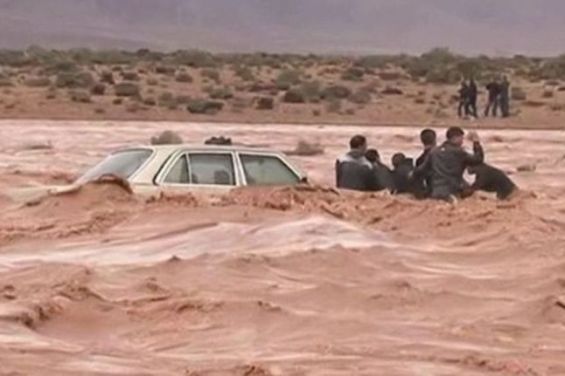Since the 1950s until 2019, Morocco has experienced more than 80 flood events, leading to significant human and economic losses. Although seasonal, floods pose a recurring threat across many regions of the country, claiming lives, destroying homes and infrastructure, and disrupting agriculture.
According to data compiled by researchers, floods have had a particularly devastating impact on Moroccans in recent decades. Historical records show that between 1970 and 2020, floods were the most frequent natural disaster in Morocco and had the greatest human toll.
A 2022 assessment titled «Flood Risk Management Practices in Morocco: Facts and Challenges» by Moroccan researchers Dalila Loudyi, Moulay Driss Hasnaoui, and Ahmed Fekri from Hassan II University in Casablanca revealed that floods were the most common and deadly natural disaster between 1970 and 2020. The study found that floods accounted for 62.1% of all natural disaster events, compared to 33.8% for earthquakes, 3.3% for storms, and 0.8% for landslides.
In terms of fatalities, floods were responsible for 42.1% of deaths caused by natural disasters during this period. Extreme temperatures followed with 15.8%, while droughts, storms, and insect infestations each accounted for 10.5%. Earthquakes and landslides were responsible for 5.3% of deaths each.
Flood events from 1970 to 2020
Since the 1970s, floods have been a recurring disaster in Morocco. An inventory of past flood events from 1970 to 2020, compiled by the researchers, highlights several notable incidents. On January 22, 1970, a flood in northern Morocco claimed 11 lives and caused $30 million in economic damage. In April 1975, 10 people perished in a flood in the western provinces. Other major floods occurred in October 1979 in Ouarzazate, killing 16, and in January 1985 in Guelmim, where the Oum Laachar wadi flooded.
The year 1995 was particularly devastating, with multiple severe floods. In April, 18 people died in Tata after the Akka wadi flooded, leaving 350 families homeless and causing $9 million in damage. In August of that same year, a catastrophic flood in the Ourika Valley killed 730 people and caused $9 million in damages.
A report by the Organisation for Economic Co-operation and Development (OECD) noted that the 1995 Ourika flood «is part of the collective memory of disasters in Morocco because it resulted in major losses in human life». The OECD explained that the Ourika Valley has a steep slope and rocky, impermeable soil, making the wadi particularly reactive to heavy rainfall, which led to a massive flow of water that devastated villages.
 August 1995 floods in Ourika Valley. / Ph. Agence de Bassin Hydraulique de Tensift
August 1995 floods in Ourika Valley. / Ph. Agence de Bassin Hydraulique de Tensift
Just one month after the Ourika disaster, a flood in the Amlil wadi in the Taza-Taounate area claimed 43 lives. In 1996, floods in Beni Mellal killed 25 people and caused $55 million in damages. The following year, 60 people died in El Hajeb due to flooding.
During the 2000s, floods became almost yearly occurrences, impacting increasingly urbanized and densely populated areas. For example, in 2000, floods in the Martil plain and Tetouan killed six people. In 2001, floods in Settat and Essaouira resulted in 16 deaths and $2.2 million in damages.
In 2002, a series of floods across Mohammedia, Berrechid, Settat, and Fez killed 80 people, left 17 wounded, and caused 26 to go missing. The floods also damaged 44 industrial units, including a fire at the SAMIR oil refinery, and destroyed 1,334 homes, agricultural lands, and livestock, resulting in $200 million in economic losses.
Floods continued to devastate Morocco in subsequent years. In 2003, floods in Nador and El Hoceima killed 35 people. In May 2006, floods claimed six lives in Errachidia and damaged 140 homes, hotels, roads, and water supply pipes in Merzouga. In 2008, nine people died in Marrakech, and 30 more perished in Tangier, where industrial units suffered heavy damage.
In February 2009, 29 people died in a flood in the Gharb region, which destroyed 400 homes and 100,000 hectares of agricultural land. In December of the same year, five people were killed by flooding in the Middle Draa Valley.
 Floods in Tetouane. / Ph. DR
Floods in Tetouane. / Ph. DR
In 2010 alone, 42 people lost their lives in floods that struck Bouskoura, El Ksiba, Taza, Midelt, Khenifra, Tifelt, Al Hoceima, Ouazzane, Bouznika, Ouarzazate, Zagora, Sale, Rabat, and Casablanca. In Bouskoura, schools, the OCP phosphate production company headquarters, and several buildings were flooded, with total economic damages estimated at $29 million.
Between 2012 and 2019, 89 people died in a series of floods that hit Taroudant, Agadir, Tetouan, M’diq, the Guelmim region, Sidi Ifni, Ouarzazate, Sale, Rabat, Zagora, Tata, and Errachidia, destroying over 200 homes in Taroudant alone and injuring 27 people in Errachidia.
Rapid urbanization, poor city planning and climate change
The Hassan II University researchers observed familiar patterns in these floods, noting that Morocco frequently experiences floods near the Rif and Atlas Mountains. These floods can be categorized into slow-moving floods on flat plains, fast-moving floods in steep, plantless areas, and city floods where drainage systems are overwhelmed by heavy rainfall.
According to the researchers, factors contributing to floods include rapid urbanization, poor city planning, neglected waterways, and climate change, which has led to more intense rainfall. As cities expanded and traditional agriculture declined, floods became more problematic. While Morocco has built dams to control water flow, these projects have been costly, and the government has struggled to finance them, researchers noted.
The OECD also points out that Morocco’s geological and hydrological characteristics make it especially vulnerable to floods. «The inhospitable terrain and steep-sided valleys of the Rif Mountains, the Middle Atlas, and the High Atlas create conditions for particularly reactive hydrology during periods of abundant rainfall», the OECD explains.
Although Morocco has experienced severe floods in the past, such as those in Sefrou in 1950 and in the Moulouya and Ziz valleys in 1963 and 1965, the last two decades have seen more frequent and widespread flooding. The OECD attributes this trend to increased human occupation of vulnerable areas, urbanization, and the loss of natural plant cover.
◀️ الصور من دوار "اوكرضا" التابع لنفوذ إقليم طاطا، حيث تتواصل تعبئة السلطات المحلية وكافة المتدخلين من أجل فك العزلة عن المناطق المتضررة وتقديم الدعم اللازم للساكنة. #المغرب #فيضانات pic.twitter.com/hHmbCEj58u
— 2M.ma (@2MInteractive) September 9, 2024
Based on data from the World Bank, the OECD estimates that average annual flood-related losses in Morocco amount to 4.2 billion dirhams. This figure could rise to as much as 27.5 billion dirhams for a once-a-century flood and 34 billion dirhams for a once-in-a-millennium event.
Since 2019, floods have continued to claim lives and damage infrastructure in Morocco. The floods that struck both Tetouan and Tangier in February 2021 claimed the lives of 28 workers who were trapped in a clandestine textile workshop. Most recently, 11 people died in Tata, Errachidia, and Tiznit following heavy rains over the weekend.





 chargement...
chargement...












